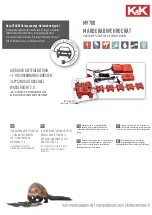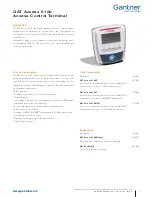
“UP” and “DOWN” buttons and confirm
with the “set” button. Move on to the next
parameter.
PLEASE NOTE: We strongly recommend
that you switch the instrument off and on
again each time parameter configuration is
changed in order to prevent malfunction-
ing of the configuration and/or ongoing
timings.
PASSWORD
Passwords “PA1” and “PA2” allow level 1
and level 2 parameters to be accessed.
There are no passwords in the standard
configuration.
To enable them (value
≠
0) and assign
them the desired value, access the
Programming menu in the “diS” folder. If
passwords are enabled, they will be
requested:
- PA1 when entering the Programming
menu (see the “Programming Menu“ sec-
tion);
- PA2 in the “Cnf” folder containing level 1
parameters.
ACTIVATING MANUAL DEFROST CYCLE
To activate the defrost cycle manually,
press the “UP” button (if configured =1)
for 5 seconds.
If there are not the right defrosting condi-
tions (the temperature of the evaporator
probe is higher than the end of defrosting
temperature, for example) or parameter
OdO
≠
0, the display will flash three (3)
times to indicate that the operation will
not be performed.
USING THE COPY CARD
The Copy Card is an accessory connected
to the TTL serial port used for quick pro-
gramming of the unit parameters (upload
and download parameter map to one or
more units of the same type). Operations
are described below:
Fr-Format (level 2 parameter)
This command can be used to format the
copy card necessary when used for the
first time or when used with models that
are not compatible.
Warning: when the copy card has been
programmed using the “Fr” parameter all
the data entered is cancelled.
This operation cannot be undone.
UL-Upload
This operation unloads the programming
parameters from the instrument.
dL-Download
This operation downloads the program-
ming parameters to the instrument.
NOTE:
• UPLOAD: instrument —> Copy Card
• DOWNLOAD: Copy Card —> instr.
The operations are performed by accessing
the folder identified by the “FPr” label and
selecting the “UL”, “dL” or “Fr” commands.
The operation is confirmed by pressing the
“set” button. If the operation is successful,
a “y” is displayed whereas if it is unsuc-
cessful an “n” will be displayed.
Download “from reset”
Connect the copy card with the instrument OFF.
When the instrument is switched on the
programming parameters will be down-
loaded; when the lamp test has been com-
pleted, the following appear on the display
for about 5 seconds:
• label dLY if copy operation is successful
• label DLn if operation fails
PLEASE NOTE:
• after downloading the instrument will
work with the parameter map settings that
have just been downloaded.
DISTANCE-MANAGED SYSTEMS
The Televis remote control systems can be
connected using the TTL serial port (the
TTL- RS 485 BUS ADAPTER 100 interface
module must be used).
To configure the instrument to do this,
you need to access the folder with the
“Add” label and use the “dEA” and “FAA”
parameters.
KEYBOARD LOCKED
Keyboard operating can be locked by pro-
gramming the “Loc” parameter (see folder
with “diS” table). If the keyboard is locked
you can access the Programming Menu by
pressing the “set” button.
The Set point can also be displayed.
ADVANCED FUNCTIONS
LINK
The Link function is used to connect up to
8 instruments (1 Master device and 7 slave
and echo devices). The distance between
one device and another must be 7 metres
maximum whereas the maximum distance
between the first and last instrument in the
network must be approximately 50m.
PLEASE NOTE: the serial link between the
devices is powered.
Master
Instrument that controls the networks and
sends commands to the Slaves. The Master
is selected using parameter L00 (the value 0
defines the Master)
Slave
Instrument(s) supplied with own controls
that also perform(s) commands issued by
the Master (with parameters L00..L07).
Echo
Instrument(s) that only display(s) the values
of the instrument that it is associated with
(it does not therefore have its own I/O
resources but only serves as a repeater).
PLEASE NOTE: only one Echo can be con-
nected to the same instrument (Master or
Slave; if it is connected to a Slave, you must
set parameter L04=n).
Defrosting
The Link network controls defrosting. The
Master sends the defrost command which
can be performed synchronously (at the
same time) or sequentially (one defrost
after another) without affecting the normal
protections or delays for each instrument
(see parameter L03).
Other Functions
The Master can also activate the functions
associated with buttons or the Digital Input
for all the Slaves: switching lights on/off,
alarm silencing, auxiliary set point, auxiliary
relay, stand-by (on/off) and functions relat-
ed to Night & Day controller (see parame-
ter L05).
The Master can also synchronize the dis-
plays on the Slave or Echo devices with the
display on the Master or a Slave (for the
Echo devices) (see parameter L04).
NOTE: synchronized defrosting refers to
actual defrosting and not to dripping and
subsequent phases.
The defrost LED on the Slave units blinks
when synchronized defrosting has terminat-
ed and the Slaves are awaiting for the ther-
mostat control to be enabled by the Master.
The functions are associated with the
instruments by correctly setting the para-
meters (see the parameter table for the
folder with the “Lin” label)
DEFROST CONTROL
The instrument can be used to select dif-
ferent types of defrosting with the para-
meter dty, defrost type.
(defrost execution mode).
The dty parameter can have these values:
0 = electrical defrosting; the compressor is
turned off.
1 = cycle reversing defrosting (hot gas);
the compressor continues operating.
2 = Free mode defrosting (compressor dis-
abled).
Configuration of 3
rd
probe as 2nd evap-
orator probe
The 3
rd
probe can be used to control the
defrosting of a second evaporator by con-
figuring a relay output as a 2nd evaporator
defrost relay (see par. H21…H26).
To implement this function:
a) configure the 3
rd
probe in 2nd evapora-
tor defrost control mode (par. H43=2EP).
b) configure a relay output as 2nd evapo-
rator defrost relay (configuration parame-
ters H21…H26).
c) define the defrost mode by setting
parameter H45.
Start of defrosting
If two evaporators are used, defrosting
starts in three different ways that are
determined by parameter H45.
• H45=0: Defrosting is enabled by con-
trolling that the temperature of the 1st
evaporator is lower than parameter dSt,
•H45=1: Defrosting is enabled by control-
ling that at least one of the two probes is
below its end of defrosting temperature
(dSt for the 1st evaporator and dS2 for
the 2nd evaporator)
• H45=2: Defrosting is enabled by control-
ling that both the probes are below their
respective end of defrosting set points
(dSt for the 1st evaporator and dS2 for
the 2nd evaporator).
The probe error condition is considered as
ID 985 LX Fan Condenser
2/11





























